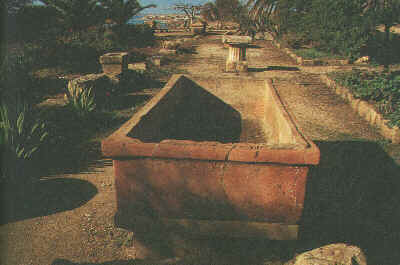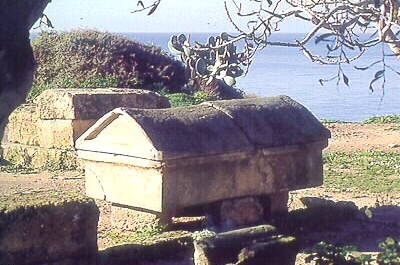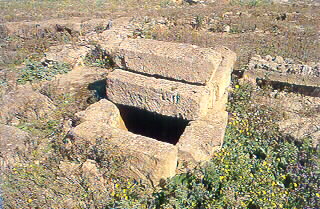 The
area of the Great City of Dead consists of the Necropolis of Manicalunga,
on the west side of Modione river, the widest and most recent necropolis,
beginning near the Malophoros
sanctuary, 3 km deep; the second Necropolis,
on the east side of Modione river, in the country Galera-Bagliazzo, called
Manuzza, expanding on a surface of about 4500 square meters; the third, in
locality Buffa, in the east side of Modione river, is less rich of ceramic
material. The
area of the Great City of Dead consists of the Necropolis of Manicalunga,
on the west side of Modione river, the widest and most recent necropolis,
beginning near the Malophoros
sanctuary, 3 km deep; the second Necropolis,
on the east side of Modione river, in the country Galera-Bagliazzo, called
Manuzza, expanding on a surface of about 4500 square meters; the third, in
locality Buffa, in the east side of Modione river, is less rich of ceramic
material.
There are also the necropolis of Pipio and Gaggera.
The burial sets present a mixed ritual. Most part of the tombs are
interment tombs, a minor number are cremation tombs, according to the
custom of burning the dead, while interment is the custom of burying the
dead.
 The
age of adults was on an average between 19 and 29 years. The
age of adults was on an average between 19 and 29 years.
The mortality in the early childness was very high: on 12 children buried
in a cemetery, 9 had died before reaching the age of ten, that's to say
the 75%.
There are different kinds of tombs and Professor Tusa divides them into
"tomba terragna" (the corpse was laid to rest on the hare ground
or perhaps into a wooden coffin), "tomba in costruzione" (the
corpse was laid to rest into a hollow made of syuare ashlars), "tomba
cappuccina" (the corpse was laid to rest into a small hollow made of
terracotta slabs), "tomba a fossa' (the corpse was laid to rest into
a hollow dug in the rock according to the dead's size), "tomba a
sarcofago" (the corpse was laid to rest in a stone or terracotta
sarcophagus), "deposizione (the dead's cremated remains are preserved
in a vase.
 The
"pietas" of relatives and friends accompanied the dead with
oil-lamps to which a magic meaning was ascribed; they were considered
necessaries to lighten the darkness of the Chereafter. The
"pietas" of relatives and friends accompanied the dead with
oil-lamps to which a magic meaning was ascribed; they were considered
necessaries to lighten the darkness of the Chereafter.
We often find terracotta statuettes representing the divinitie who had to
protect the dead.
|